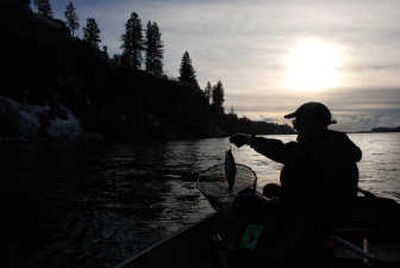Conservation Bonus

Changing farming practices have been plowing new ground for trout among the Palouse wheatfields of Whitman County.
Well-known as one of the best year-round brown trout waters in the Inland Northwest, Rock Lake has been quietly gaining a reputation for producing rainbows that are fatter than the browns, but easier for the average angler to catch.
Many farmers in the area are enrolled in the federal Conservation Reserve Program, which pays them to take some highly erodable fields out of crop production so they can be seeded with grasses and other plants ranging to evergreen trees.
“I believe Rock Lake is showing one of those unheralded side benefits of CRP,” said Chris Donley, Washington Fish and Wildlife district fisheries biologist. “You hear a lot about the benefits of CRP for birds and deer, but Rock Lake’s water quality has improved, and that’s especially good for rainbows.”
CRP is one of several wildlife conservation programs being considered for re-authorization in the 2007 Farm Bill, the House and Senate versions of which are currently being combined by a conference committee in Washington, D.C.
“Historically, the lake was stocked mostly with brown trout and a few catchable-size rainbows because the lake was quite turbid,” Donley explained. “Brown trout grow better than rainbows in turbid waters.”
Brown trout are sight feeders that get their start selectively on the largest of the zooplanktons on up to feeding on other fish.
To paraphrase Donley, rainbows depend more on the smaller daphnia, which they consume by opening their mouths and taking in large quantities of tiny food organisms in a gulp.
“But if the water is turbid, they consume more dirt than food,” he said.
“CRP has changed the lake, making it considerably cleaner. That has shifted the zooplankton and we’re seeing higher densities of daphnia. Over the last decade, we have been able to stock more rainbows to take advantage of that shift.
“The result is that while brown trout catch rates have remained about the same, the catch rates for rainbows have increased significantly.”
The lake is being stocked with 80,000-200,000 rainbows and at least 40,000 brown trout a year, he said, noting that the lake also produces bass and other spiny-ray fish.
That’s not a heavy plant for a lake that runs more than seven miles through a narrow basalt canyon, he said.
“Rock Lake isn’t for people who want to catch a lot of 10-inch trout,” he said. “Anglers go there looking for quality. The lake is very productive.”
Spring rainbow fry plants are growing to a fat 15 inches for the winter fishery, he said.
October through March are perhaps the best months for fishing Rock Lake.
Even though roads were icy two weekends ago, more than a dozen boats were on Rock Lake. My fishing partner, Dick Rivers and I fished less than four hours casting, drifting and trolling using fly rods with sinking lines and olive-colored Bunny Leech flies.
We landed about 18 amazingly acrobatic rainbows ranging from 14 to 17 inches before we each hooked a brown trout on our last wind-powered drift along the shoreline.
The brown trout were not as robust in girth as the rainbows, but judging from the four fish I brought home for dinner, the eating quality of the rainbows and browns was almost identical.